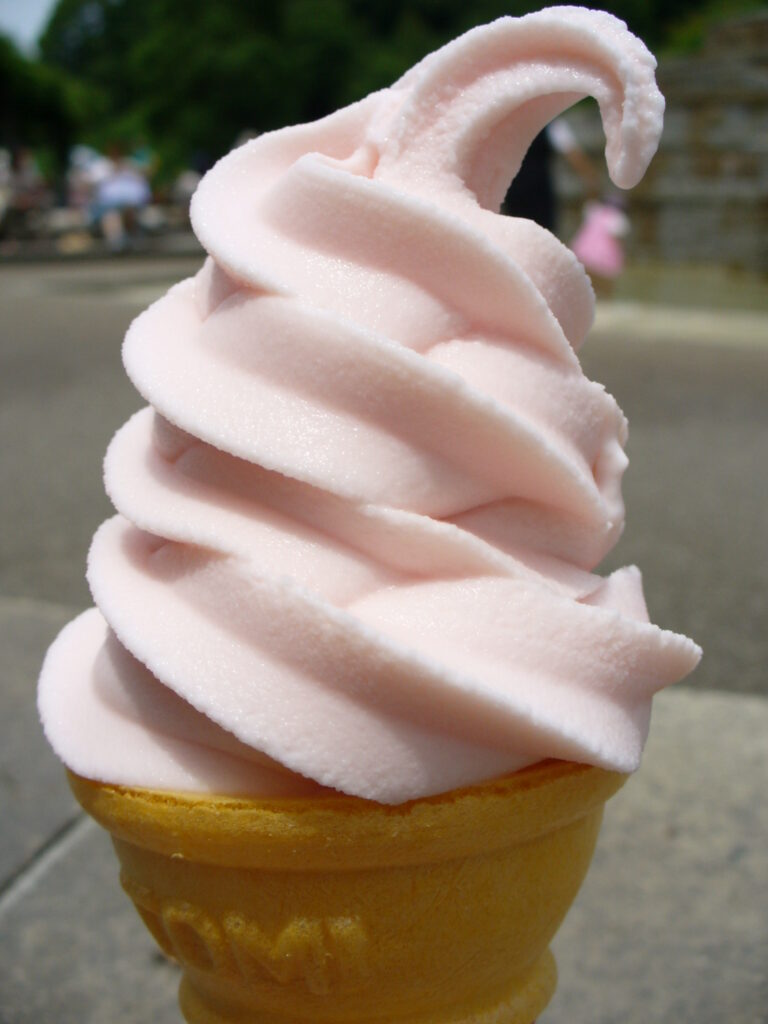Over the years I’ve had a few requests for soft serve help. Not from Mr. Softee competitors* or would-be usurpers of the throne of the Dairy Queen, but, maybe surprisingly, from chefs. They felt that something nostalgic (and maybe a bit kitschy) would work with their restaurant concept, but they wanted to keep their standards, stay in control, and make it all from scratch. Essentially, they’re working from David Chang’s playbook. But how do you do this with a traditionally industrial product like soft serve?
The hard part is that you need a soft serve machine. They’re expensive to buy, and probably not the most fun things in the world to maintain. But when they’re working, they do what they do, with very little user intervention. The difference between you, dear artisan ice cream maker, and the more typical soft-serve maker, is that you want to make your soft serve from scratch—and make well!—rather than buy some over-sweetened mystery and an artificial flavoring kit.
Is it Just Regular Ice Cream Made in a Soft Serve Machine?
Not quite. The fundamentals are similar, but the proportions are different. Here are some basic differences:
Serving temperature is warmer—typically -6°C to -8°C. Contrast this with -14°C for standard ice cream, or the softer Italian gelato styles that are served at -10°C to -11°C.
Fat is lower—typically 4% to 7%. Roughly half the fat of standard ice cream. For an richer than normal product, you can go as high as 10%. Higher than this, you’re likely to lose some of the lightness that people value in soft-serve. Higher than 12% (or lower than 4%) you can expect technical problems—either iciness or fat churning into butter. For reference, according to Douglas Goff, McDonalds uses 4% fat; Dairy Queen uses 5%.
Milk solids are higher. Generally, the lower the fat, the higher the milk solids. For a soft serve with 4% fat, you could go as high as 14% milk solids non-fat (MSNF). This is about keeping the total solids high enough to prevent iciness. I like to see total solids (fat plus non-fat solids) at 36%. The higher the solids, the more overrun you can achieve in the soft-serve while still maintaining satisfying body. Overrun can range from 30% to 60%.
Sugar is a bit lower. This is less about sweetness than about balancing the lactose in the high levels of milk solids. Typically 13% to 15%, compared with 15%-18% in standard ice creams. I usually push for lower sweetness than what’s standard, but this is accomplished through the blend of sugars. For soft-serve, I don’t drop the sweetness as low as I do for standard ice creams, because I don’t want to make them too “adult.”
Stabilizers are optional, and only used for texture enhancements. Typical usage is 0.2 to 0.3% total mix weight. I recommend using 0.15% the total water weight of the recipe as a starting point. You don’t have to worry about icy textures if your formula is properly designed and the machine is working properly (and you’re selling it reasonably quickly). So use a stabilizer blend that gives a texture that you like. [Correction 3-19-2023: earlier version recommended 0.35% by water weight. Typo]
Emulsifiers are required. You need them to get a proper dry surface consistency, good whipability, and good shape-holding qualities. Emulsifiers help control the foam structure, especially at the fat-air interface. Soft-serve is all about the foam structure. Typical usage is 0.1% to 0.2% the recipe weight. I recommend using 0.35% of the total fat weight as a starting point. A 1:5 ratio of Polysorbate-80 and Mono/Diglycerides works very well.
Flavorings can’t be chunky. You’ll gum up the machine. Use liquids, or solids that can dissolve or be completely dispersed in a high-powered blender.
Sample Recipe
Vanilla, with 10% fat—a relatively luxurious soft-serve
547g Whole Milk
230g Heavy Cream 36%
15g Vanilla Extract
60g Skim Milk Powder
112g Sucrose
10g Dextrose
20g Atomized Glucose DE40
0.5g Polysorbate-80
3.0g Mono/Diglycerides
3.5g Tara Gum (or 1.75g Locust Bean Gum + 1.75g Guar Gum)
0.8g Salt
1000g Total
Analysis
Total Fat: 10.1%
Milk Fat: 10.1%
Total Solids: 36.3%
Solids Nonfat: 26.2%
Milk Solids Nonfat: 11.4%
Acidity: 0.2%
Alcohol: 0.5%
Stabilizer/Water: 0.35%
Emulsifiers/Water: 0.35%
POD: 136 / 1000g
PAC: 263 / 1000g
Absolute PAC: 511 / 1000g
Rel. Hardness @ -8°C: 58 (for soft-serve the target is 55–60)
References
Goff, H. D., & Hartel, R. W. (2013). Ice Cream. 7th Ed. Springer Publishing.
*If you want to compete with Mr. Softee, bring a bat.


Hey underbelly, why dont you use your standard stabiliser mix of ratio 4:2:1 for locust bean gum:Guar gum:Lamda Carrageenan?
You could use that blend. But you don’t have to. You can keep it simple with something like tara gum (which promotes a rich texture) and not suffer any consequences. Because you don’t need the stabilizer for all the technical reasons you need it for in standard ice cream.
This is excellent thank you. Is the process just everything in the blender until smooth? Also, for chocolate base would it be simply the same swapping vanilla for cocoa powder?
It should be cooked / pasteurized just like standard ice cream, to denature the milk proteins. And you may need the heat to hydrate the stabilizers. Otherwise, yes—blend, chill, and pour in the machine (the machine may allow you to add hot ingredients; see the instructions).
You could swap cocoa for vanilla. You’ll get better results if you recalculate the formula to account for the added solids, fats, and bitterness in the cocoa.
This is very helpful, thanks so much. But your emulsifier text says 0.35% of total fat weight, while in your recipe you’re using 0.35% of the total weight. Just want to check which is right, thank you